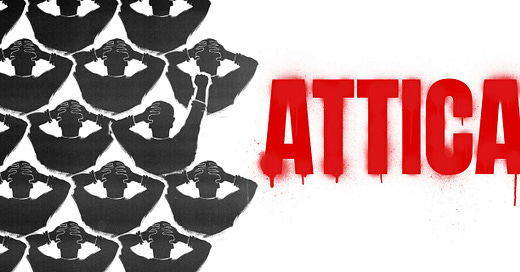Lessons from Attica
Reflecting on the state-sanctioned murder of 33 prisoners and 9 guards at Attica state prison in 1971.
Today I had the privilege of watching the powerful, poignant, and infuriating documentary on the 1971 Attica prison uprising. I must acknowledge upfront that I was totally ignorant of the event that culminated in the state troopers’ and prison guards’ execution of 33 inmates, 9 prison guard hostages, and countless injured prisoners.
After four days, Thursday through Sunday, of negotiations—not for release from prison but simply for humane treatment within its walls—a police helicopter dropped tear gas into the prison yard and effectively incapacitated the prisoners, including those who had knives held to hostages’ throats. Archival footage clearly records the police chopper’s speakers announcing that the prisoners would not be hurt if they put their hands on their heads and turned themselves in to the nearest police officer. When prisoners attempted to do this, they were executed by sharpshooters and shotgun-toting prison guards. The prisoners had no firearms and barely had improvised melee weapons. Interviews with the prisoners reveal that the prison guards shouted “Save me a n*gger!” while ruthlessly gunning down prisoners and prison guard hostages alike. Footage from outside the prison shows one officer shouting, “That’s white power!” immediately after the carnage took place.
After the shooting had ended, prisoners were forced to disrobe, crawl along the blood-soaked dirt of the prison yard, others forced to crawl through the latrine, and then all made to run through a gauntlet within the prison block back to their cells across floors covered in shattered glass while prison guards beat them with batons. Whil two prisoners were convicted for the murder of one of the correctional officers, William E. Quinn, at the onset of the riot, not a single prison guard was held legally accountable for the mass execution. That National Guard troops that came in afterwards to medically evacuate injured prisoners were ordered by their commanding officer to not utter a word about the brutality they witnessed first-hand.
The documentary depicts acts of barbarity carried out by agents of the state that were totally absolved of all responsibility for the sheer evil that occurred. Having recently read Zimbardo’s paper on the Stanford Prison Experiment, “Interpersonal Dynamics in a Simulated Prison,” I found the film’s depiction of a real-life example of the depravity that results from dehumanizing prisoners and elevation of guards above natural, moral law to be particularly hard-hitting. I encourage all of my readers to watch Traci A. Curry and Stanley Nelson Jr.’s expertly made documentary.
I leave my readers with this ominous quote from one of the leaders of the prison rebellion: “If we cannot live as people, we will at least try to die like men.” Tragically, the men, the human beings confined in Attica state prison, were treated in their murder as they were treated in life: like subhuman beasts. The moral depravity of this crime must not be forgotten.




